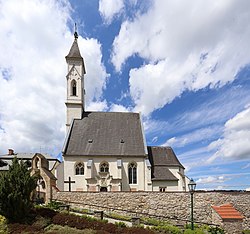Seebenstein
Appearance
Seebenstein | |
|---|---|
 | |
| Coordinates: 47°42′N 16°9′E / 47.700°N 16.150°E | |
| Country | Austria |
| State | Lower Austria |
| District | Neunkirchen |
| Government | |
| • Mayor | Walter Endl |
| Area | |
| • Total | 9.09 km2 (3.51 sq mi) |
| Elevation | 348 m (1,142 ft) |
| Population (2018-01-01)[2] | |
| • Total | 1,401 |
| • Density | 150/km2 (400/sq mi) |
| Time zone | UTC+1 (CET) |
| • Summer (DST) | UTC+2 (CEST) |
| Postal code | 2824 |
| Area code | 02627 |
| Website | www.seebenstein.at |
Seebenstein is a town in the district of Neunkirchen in the Austrian state of Lower Austria.
Geography
Seebenstein is in the industrial quarter of Lower Austria. The town covers 9.09 square kilometers and is 62.71 percent forested. The town includes the Seebenstein nature park and historic ruin of the Turkensturz. The town is overlooked by Burg Seebenstein.
History
In ancient times, Seebenstein was part of the Celtic kingdom of Noricum.
On april 16th 1972, Seebenstein was the center of a magnitude 5.3 earthquake[3]
Historical population
| Year | Pop. | ±% |
|---|---|---|
| 1869 | 587 | — |
| 1880 | 700 | +19.3% |
| 1890 | 768 | +9.7% |
| 1900 | 872 | +13.5% |
| 1910 | 979 | +12.3% |
| 1923 | 1,049 | +7.2% |
| 1934 | 952 | −9.2% |
| 1939 | 967 | +1.6% |
| 1951 | 1,075 | +11.2% |
| 1961 | 1,033 | −3.9% |
| 1971 | 1,088 | +5.3% |
| 1981 | 1,040 | −4.4% |
| 1991 | 1,139 | +9.5% |
| 2001 | 1,196 | +5.0% |
| 2011 | 1,326 | +10.9% |

Demographics
In the 2001 census the population was described as 84.4% Roman Catholic, 3.8% evangelical, 0.5% Muslim, 0.3% Orthodox Christian, and 9.4% with no religion.
References
- ^ "Dauersiedlungsraum der Gemeinden Politischen Bezirke und Bundesländer - Gebietsstand 1.1.2018". Statistics Austria. Retrieved 10 March 2019.
- ^ "Einwohnerzahl 1.1.2018 nach Gemeinden mit Status, Gebietsstand 1.1.2018". Statistics Austria. Retrieved 9 March 2019.
- ^ "Stärkste Erdbeben — ZAMG". www.zamg.ac.at. Retrieved 2021-01-24.


